有机食品行业市场研究分析报告.pptx
- 格式:pptx
- 大小:2.21 MB
- 文档页数:20
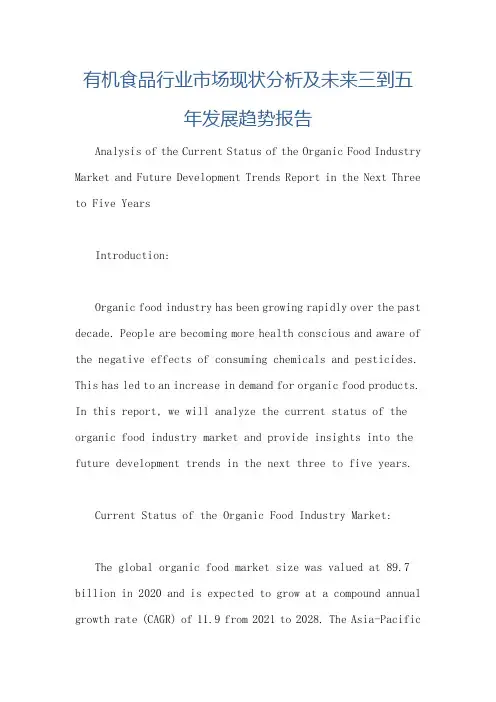
有机食品行业市场现状分析及未来三到五年发展趋势报告Analysis of the Current Status of the Organic Food Industry Market and Future Development Trends Report in the Next Three to Five YearsIntroduction:Organic food industry has been growing rapidly over the past decade. People are becoming more health conscious and aware of the negative effects of consuming chemicals and pesticides. This has led to an increase in demand for organic food products. In this report, we will analyze the current status of the organic food industry market and provide insights into the future development trends in the next three to five years.Current Status of the Organic Food Industry Market:The global organic food market size was valued at 89.7 billion in 2020 and is expected to grow at a compound annual growth rate (CAGR) of 11.9 from 2021 to 2028. The Asia-Pacificregion is expected to witness the fastest growth during the forecast period. The demand for organic food products is increasing due to the growing awareness of the health benefits associated with organic food products.The organic food industry market is characterized by the presence of several players, both global and regional. The key players in the market are focusing on expanding their product portfolio and geographic reach through mergers and acquisitions. For instance, in 2020, Nestle acquired Freshly, a meal delivery service that offers organic food products, to expand its product portfolio in the organic food segment.The COVID-19 pandemic has also played a significant role in the growth of the organic food industry market. Consumers are becoming more health-conscious and are willing to pay a premium for organic food products. The pandemic has also led to an increase in online sales of organic food products.Future Development Trends in the Next Three to Five Years:1. Increasing Demand for Organic Food Products:The demand for organic food products is expected to increase in the next three to five years due to the growing awareness of the health benefits associated with organic food products. The trend towards healthy eating is expected to continue, which will drive the growth of the organic food industry market.2. Expansion of Online Sales:The COVID-19 pandemic has led to an increase in online sales of organic food products. This trend is expected to continue in the next three to five years as consumers become more comfortable with online shopping. E-commerce platforms are expected to play a significant role in the growth of the organic food industry market.3. Rise of Plant-Based Organic Food Products:The trend towards plant-based food products is expected to continue in the next three to five years. Consumers are becoming more conscious of the environmental impact of consuming animal products. This has led to an increase in demand for plant-basedorganic food products.4. Investment in Research and Development:The key players in the organic food industry market are expected to invest heavily in research and development to innovate and introduce new products. This will help them to expand their product portfolio and gain a competitive edge in the market.Conclusion:The organic food industry market is expected to grow rapidly in the next three to five years due to the increasing demand for organic food products. The rise of online sales, the trend towards plant-based food products, and investment in research and development are expected to be the key growth drivers for the industry. The key players in the market are expected to focus on expanding their product portfolio and geographic reach through mergers and acquisitions.。



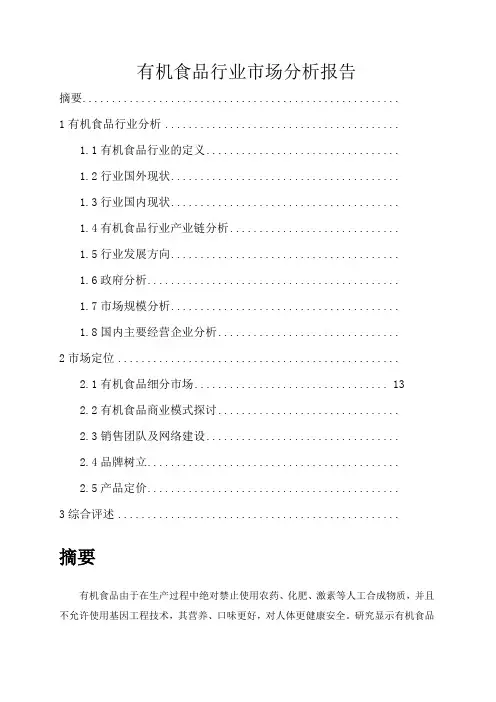
有机食品行业市场分析报告摘要......................................................1有机食品行业分析........................................1.1有机食品行业的定义.................................1.2行业国外现状.......................................1.3行业国内现状.......................................1.4有机食品行业产业链分析.............................1.5行业发展方向.......................................1.6政府分析...........................................1.7市场规模分析.......................................1.8国内主要经营企业分析...............................2市场定位................................................2.1有机食品细分市场 (13)2.2有机食品商业模式探讨...............................2.3销售团队及网络建设.................................2.4品牌树立...........................................2.5产品定价...........................................3综合评述................................................摘要有机食品由于在生产过程中绝对禁止使用农药、化肥、激素等人工合成物质,并且不允许使用基因工程技术,其营养、口味更好,对人体更健康安全。
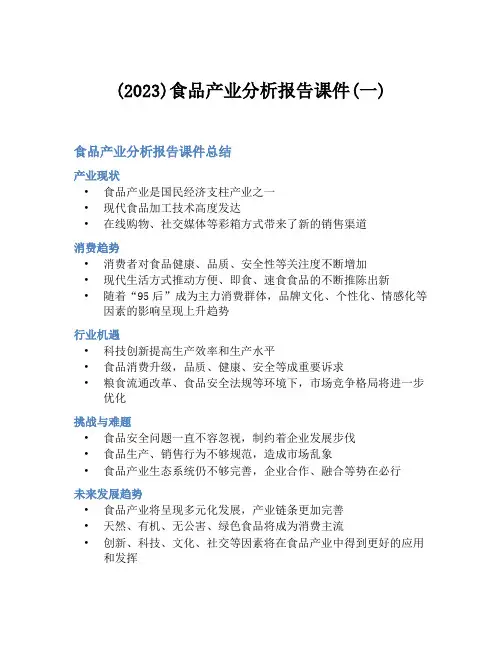
(2023)食品产业分析报告课件(一)食品产业分析报告课件总结产业现状•食品产业是国民经济支柱产业之一•现代食品加工技术高度发达•在线购物、社交媒体等彩箱方式带来了新的销售渠道消费趋势•消费者对食品健康、品质、安全性等关注度不断增加•现代生活方式推动方便、即食、速食食品的不断推陈出新•随着“95后”成为主力消费群体,品牌文化、个性化、情感化等因素的影响呈现上升趋势行业机遇•科技创新提高生产效率和生产水平•食品消费升级,品质、健康、安全等成重要诉求•粮食流通改革、食品安全法规等环境下,市场竞争格局将进一步优化挑战与难题•食品安全问题一直不容忽视,制约着企业发展步伐•食品生产、销售行为不够规范,造成市场乱象•食品产业生态系统仍不够完善,企业合作、融合等势在必行未来发展趋势•食品产业将呈现多元化发展,产业链条更加完善•天然、有机、无公害、绿色食品将成为消费主流•创新、科技、文化、社交等因素将在食品产业中得到更好的应用和发挥以上是对食品产业分析报告课件的总结,随着时间的推移,食品产业必将面对越来越多的机遇和挑战,在未来的发展道路中,产业参与者应秉持负责任的态度,不断创新、改善,助力行业长足发展。
未来市场前景•食品产业市场规模将进一步扩大,行业竞争将变得更加激烈•随着消费者健康意识的提升以及品牌文化的影响,中高端市场将成为未来重点发展方向•“互联网+”、新零售等新模式将会在食品产业中得到广泛应用,提高用户体验行业升级趋势•跨界合作成为未来行业升级的重要方式,打破传统区域限制,提升企业核心竞争力•工业化生产模式将向智能化、自动化转型,以提高生产效率和流程控制•技术创新将更多地用于加工制造、营销模式和产品设计等多个环节总之,随着消费需求的升级和技术的不断应用,食品产业将获得更广阔的市场空间和更多的机遇。
同时,也需要从产品质量、安全和环保等方面加强认识,不断优化产业生态环境,推动行业实现可持续发展。


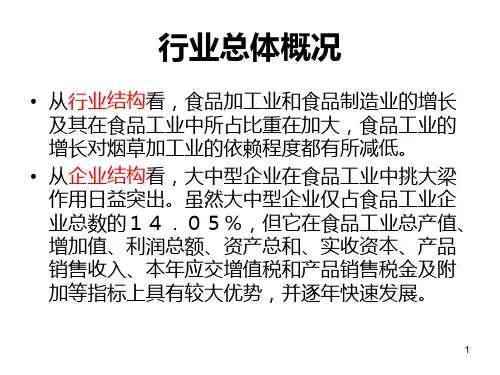

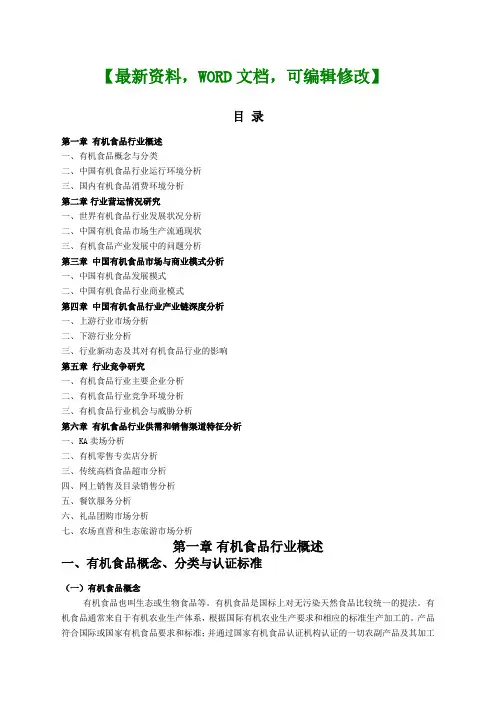
【最新资料,WORD文档,可编辑修改】目录第一章有机食品行业概述一、有机食品概念与分类二、中国有机食品行业运行环境分析三、国内有机食品消费环境分析第二章行业营运情况研究一、世界有机食品行业发展状况分析二、中国有机食品市场生产流通现状三、有机食品产业发展中的问题分析第三章中国有机食品市场与商业模式分析一、中国有机食品发展模式二、中国有机食品行业商业模式第四章中国有机食品行业产业链深度分析一、上游行业市场分析二、下游行业分析三、行业新动态及其对有机食品行业的影响第五章行业竞争研究一、有机食品行业主要企业分析二、有机食品行业竞争环境分析三、有机食品行业机会与威胁分析第六章有机食品行业供需和销售渠道特征分析一、KA卖场分析二、有机零售专卖店分析三、传统高档食品超市分析四、网上销售及目录销售分析五、餐饮服务分析六、礼品团购市场分析七、农场直营和生态旅游市场分析第一章有机食品行业概述一、有机食品概念、分类与认证标准(一)有机食品概念有机食品也叫生态或生物食品等。
有机食品是国标上对无污染天然食品比较统一的提法。
有机食品通常来自于有机农业生产体系,根据国际有机农业生产要求和相应的标准生产加工的。
产品符合国际或国家有机食品要求和标准;并通过国家有机食品认证机构认证的一切农副产品及其加工品,包括粮食、食用油、菌类、蔬菜、水果、瓜果,干果,奶制品、禽畜产品、蜂蜜、水产品、调料等。
有机食品的主要特点来自于生态良好的有机农业生产体系。
有机食品的生产和加工,不使用化学农药、化肥、化学防腐剂等合成物质,也不用基因工程生物及其产物,因此,有机食品是一类真正来自于自然、富营养、高品质和安全环保的生态食品!(二)有机食品发展概述进入21世纪以后,全球有机食品与饮料消费一直在快速增长,2009年市场价值达550亿美元,预计到2015年可达到1 000多亿美元。
全球有机食品市场规模统计:2000年中国有机农产品市场开始启动,2003年起,中国有机食品市场增长速度加快,据南京国环有机产品认证中心提供的数据,2003年国内有机食品销售额近3亿元;2004年和2003年相比则增加了4倍。
【最新资料,WORD文档,可编辑修改】目录第一章有机食品行业概述一、有机食品概念与分类二、中国有机食品行业运行环境分析三、国内有机食品消费环境分析第二章行业营运情况研究一、世界有机食品行业发展状况分析二、中国有机食品市场生产流通现状三、有机食品产业发展中的问题分析第三章中国有机食品市场与商业模式分析一、中国有机食品发展模式二、中国有机食品行业商业模式第四章中国有机食品行业产业链深度分析一、上游行业市场分析二、下游行业分析三、行业新动态及其对有机食品行业的影响第五章行业竞争研究一、有机食品行业主要企业分析二、有机食品行业竞争环境分析三、有机食品行业机会与威胁分析第六章有机食品行业供需和销售渠道特征分析一、KA卖场分析二、有机零售专卖店分析三、传统高档食品超市分析四、网上销售及目录销售分析五、餐饮服务分析六、礼品团购市场分析七、农场直营和生态旅游市场分析第一章有机食品行业概述一、有机食品概念、分类与认证标准(一)有机食品概念有机食品也叫生态或生物食品等。
有机食品是国标上对无污染天然食品比较统一的提法。
有机食品通常来自于有机农业生产体系,根据国际有机农业生产要求和相应的标准生产加工的。
产品符合国际或国家有机食品要求和标准;并通过国家有机食品认证机构认证的一切农副产品及其加工品,包括粮食、食用油、菌类、蔬菜、水果、瓜果,干果,奶制品、禽畜产品、蜂蜜、水产品、调料等。
有机食品的主要特点来自于生态良好的有机农业生产体系。
有机食品的生产和加工,不使用化学农药、化肥、化学防腐剂等合成物质,也不用基因工程生物及其产物,因此,有机食品是一类真正来自于自然、富营养、高品质和安全环保的生态食品!(二)有机食品发展概述进入21世纪以后,全球有机食品与饮料消费一直在快速增长,2009年市场价值达550亿美元,预计到2015年可达到1 000多亿美元。
全球有机食品市场规模统计:2000年中国有机农产品市场开始启动,2003年起,中国有机食品市场增长速度加快,据南京国环有机产品认证中心提供的数据,2003年国内有机食品销售额近3亿元;2004年和2003年相比则增加了4倍。